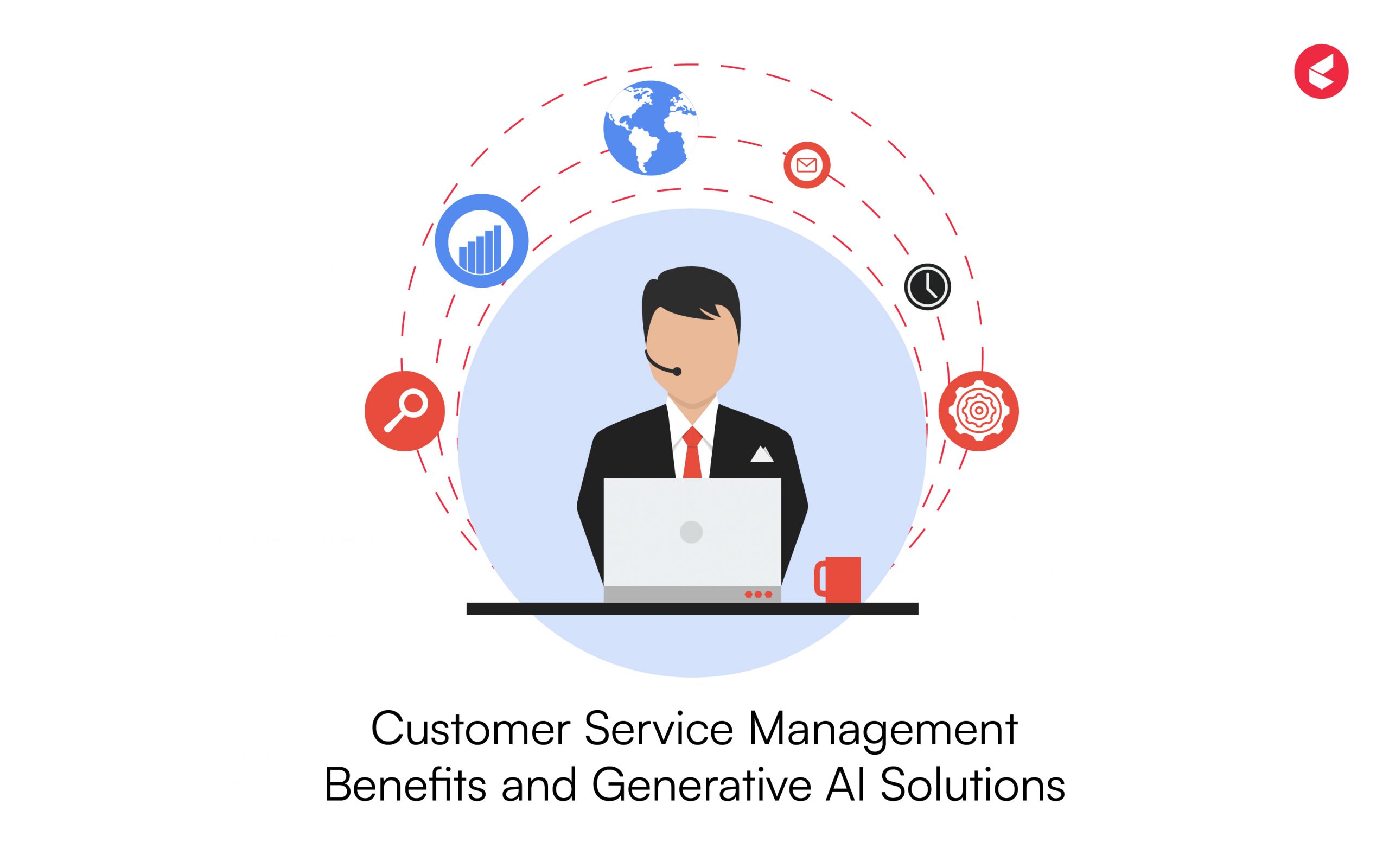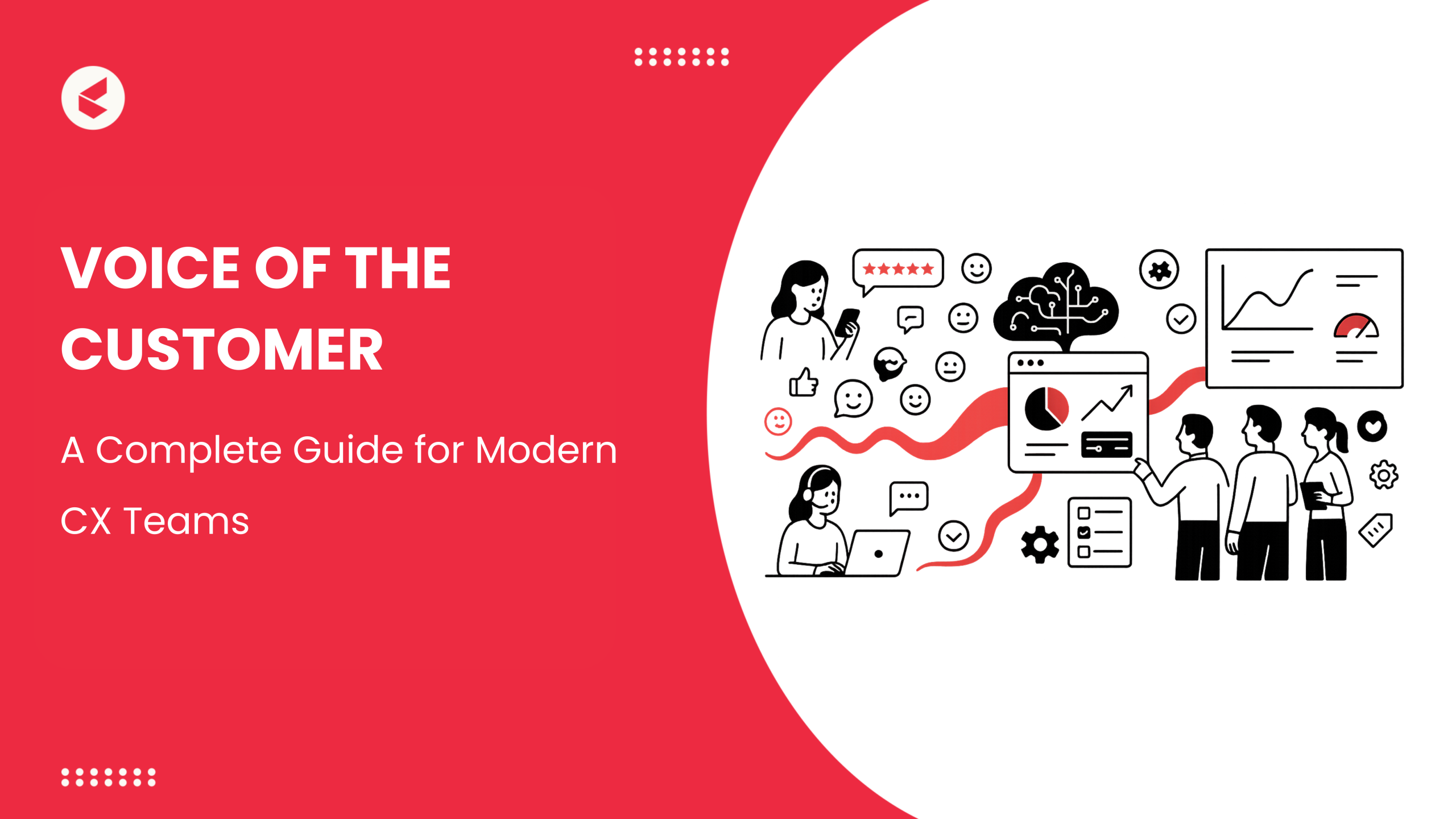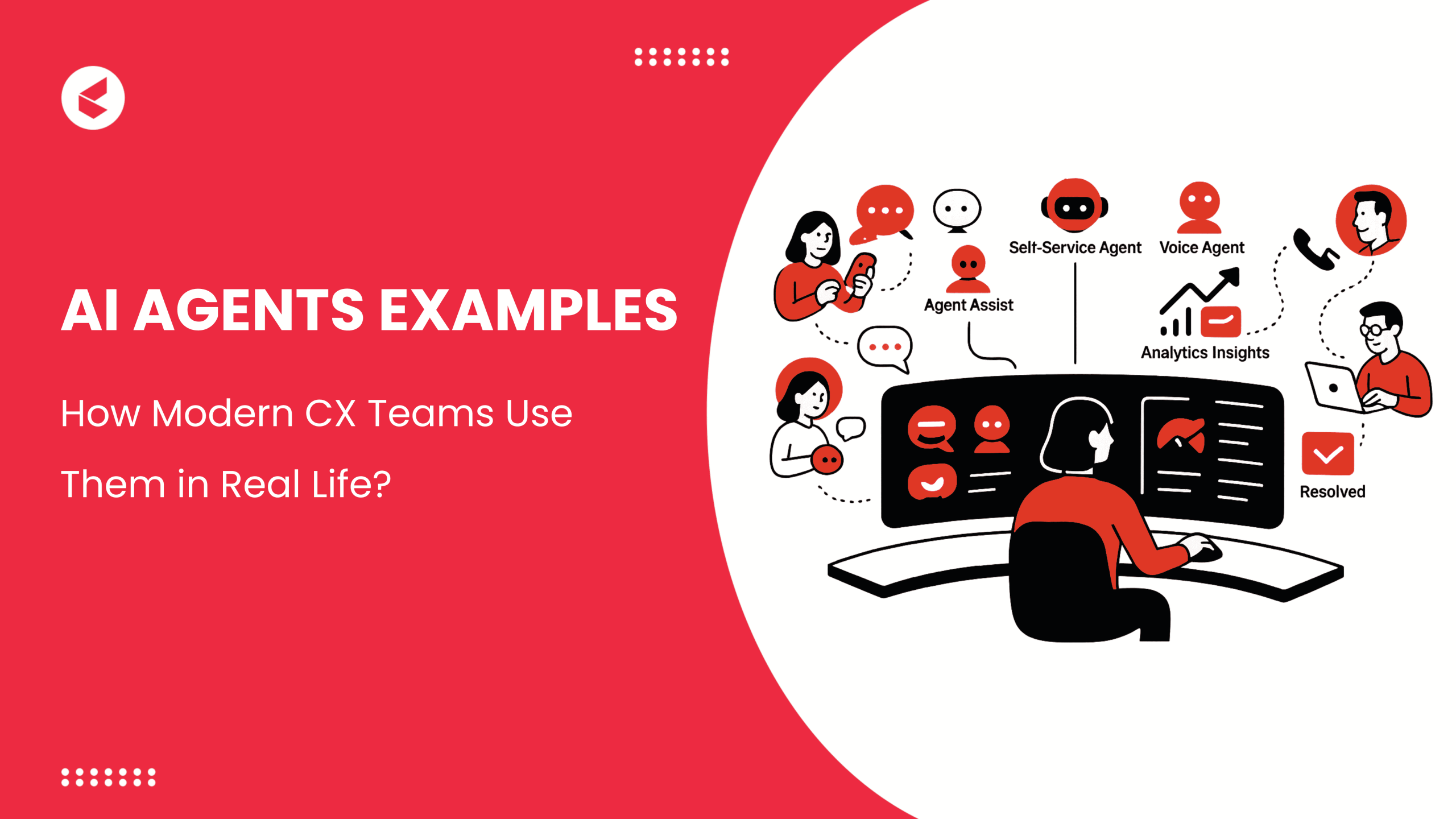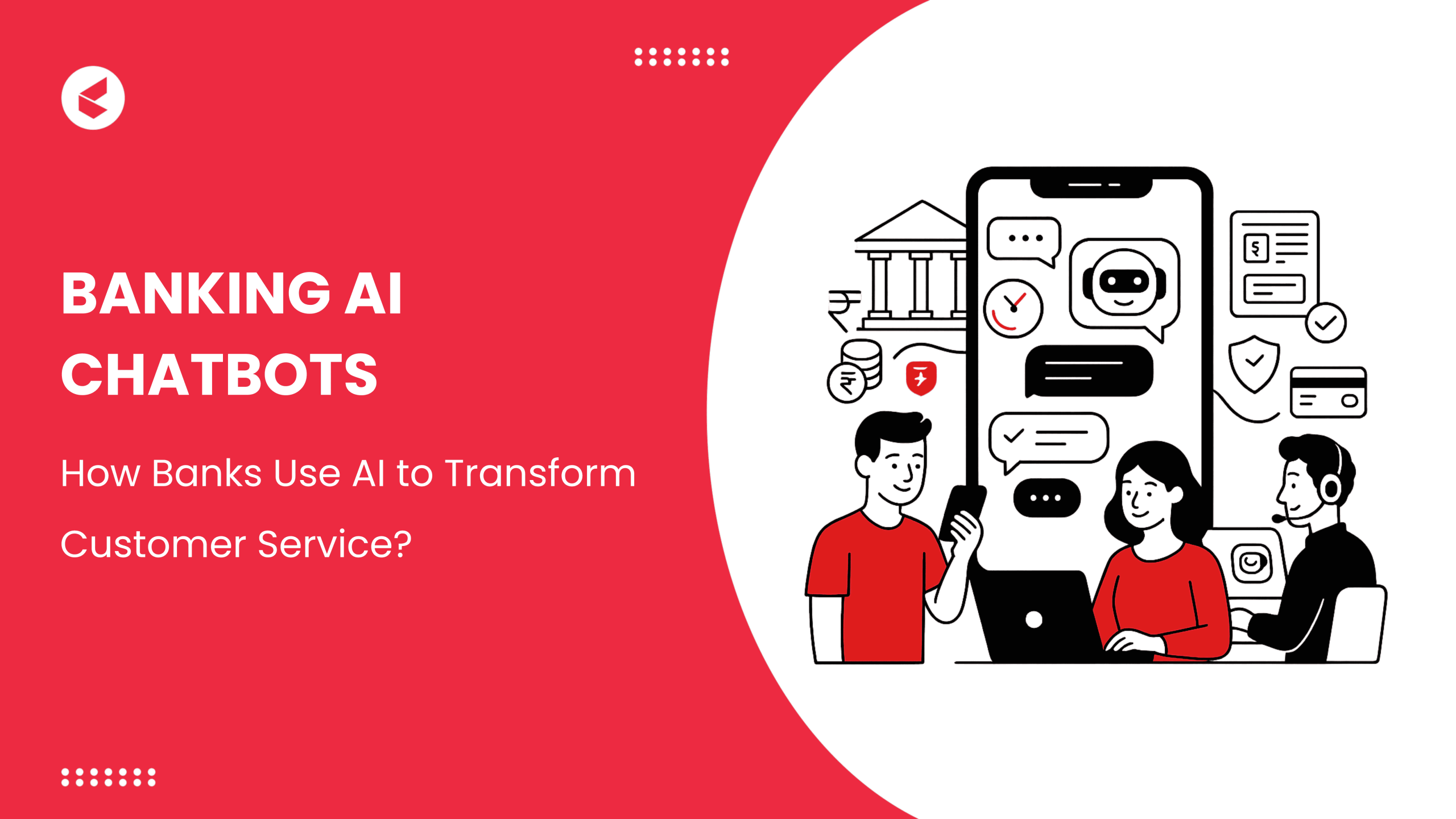“Customer service should not be a department. It should be the entire company.” – Tony Hsieh (CEO, Zappos).
No business can exist without customers. Just as you tailor your products to your customers’ needs, there is a solid reason why you should do the same with customer service.
To ensure that your business’s customers keep growing, you must enhance the quality and consistency of customer service. However, creating a customer service culture that is unrivaled—or at least a tough opponent—for competitors requires careful attention to detail. Customer service management could thus potentially be the most important aspect that your business invests in.
Let’s see what benefits your business can utilize with effective customer service and management, in addition to how you can leverage GenAI for the same.
What Is Customer Service Management (CSM)?
Customer Service Management, or CSM for short, is the exercise of facilitating customer service operations with relevant tools, training, resources, and support that empower your team to deliver exemplary customer service.
The objective of CSM is to help your brand establish a good reputation in the market and find favor with your target audience when faced with competing brands. In fact, a report by NICE highlights that 95% of consumers base their brand loyalties on the quality of customer service — now that’s something to strive for!
An effective customer service management strategy helps your business reduce customer churn and improve satisfaction and loyalty.
Why Is Managing Customer Service Important?
Customer service management is vital in ensuring that your brand stays at the top of your customers’ minds even after a sale has been made. CSM efforts empower your business to understand what your customers need and address their pain points.
For example, say that a loyal customer has had to wait in long queues whenever they called your contact centers, which caused them to churn to a competing brand. You should then make an effort to understand why the customer waiting times are so high and implement solutions that help you reduce the same.
When your business takes proactive steps to rectify customer issues so they won’t recur, you can plan a remarketing campaign to bring the lost customers back on board.
CSM helps you build long-term relationships with your customers through ongoing, productive, and responsive conversations with them.
Benefits of Customer Service Management
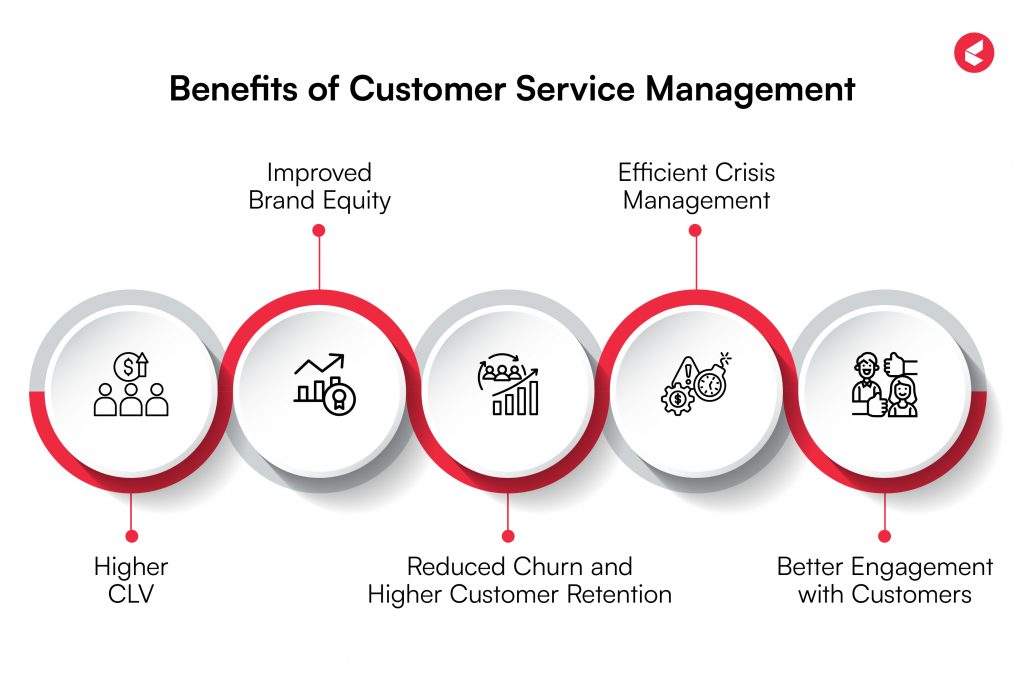
Customer service management highlights the loopholes in your service department. It enables you to see how your business can improve the quality of service it provides. Besides, there are several benefits of a proper CSM system:
1. Higher CLV
Customer Lifetime Value (CLV) is a metric that represents the total amount a customer spends on a brand over the entire period of their association. The higher the CLV, the more frequently that customer shops with your brand, representing the loyalty of your customers to your brand.
Customer service management helps you identify customers with both higher and lower CLV. Identifying customers with a low CLV enables you to find out where your service is lacking and take corrective actions accordingly. This way, you can ensure that your customers feel valued, which inturn helps you enhance the CLV with time.
2. Improved Brand Equity
Brand equity is not a tangible metric; it is a marketing term that represents the value of an opinion about a brand to a customer. By reviewing your brand equity, you can understand what sentiments your brand evokes in a customer’s mind.
For example, exemplary customer service is a positive brand equity, whereas longer wait times at contact centers are a negative one.
CSM efforts highlight your business’s negative brand equity, giving you an opportunity to work on it. An effective customer service management plan helps you lay down the foundations for good reviews and positive brand equity.
3. Reduced Churn and Higher Customer Retention
Reduced churn and higher customer retention are by-products of higher brand equity. A customer who has positive thoughts about a brand will return to it when the next requirement comes up. As mentioned earlier, 95% of customers base their brand loyalty on the quality of customer service.
Additionally, offering practical and thoughtful loyalty rewards makes customers more satisfied as they can use these incentives more readily.
4. Efficient Crisis Management
Crises are unavoidable in businesses. There may be a time when your service executives make a mistake, and you need to mobilize damage control to win back your customers’ trust. An example of a crisis is consistently being unable to meet customer service requests due to reasons like lack of proper training.
Customer service management highlights such risky gaps in various aspects of your service lifecycle, enabling you to act before it is too late.
5. Better Engagement with Customers
Customer service management allows you to understand how customers prefer to be contacted, through which channels, and when. It also helps your brand understand how to personalize your communications so that effortless conversations can occur between your agents and customers. Overall, this results in better engagement and outcomes.
What Do Customers Expect from Customer Service?
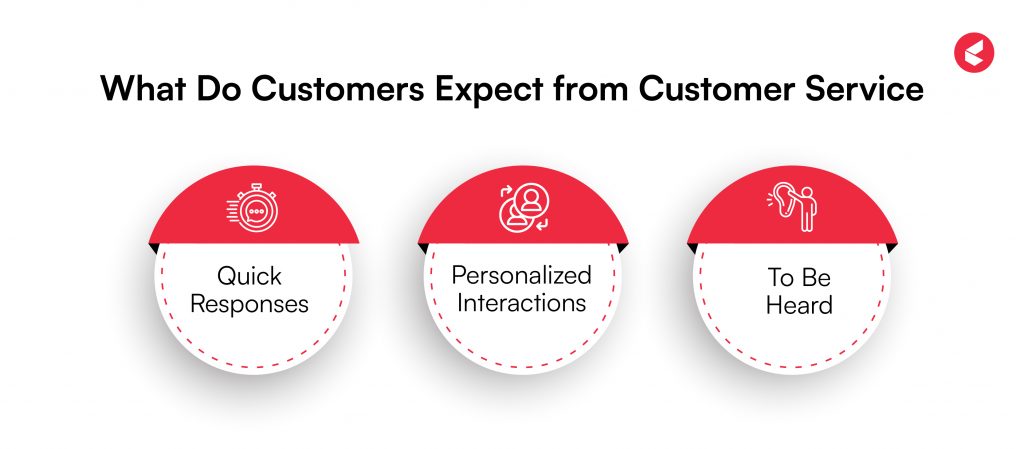
Today, customers are quite demanding, and their needs are dynamic. Depending on the convenience that modern technologies make possible, their expectations from a brand keep evolving.
The three major expectations you can anticipate from your customers are:
1. Personalized Interactions
In its report, McKinsey states that 71% of customers expect brands to deliver personalized interactions, and the absence of personalization frustrates 76% of customers.
Greeting customers by their first name, offering personalized product recommendations, and ensuring they know their queries are being heard—all while providing resolutions using their order history—are some ways to personalize customer interactions. A CSM initiates this process by gathering customer data that is accessible to agents at all times. This level of personalization enhances brand equity and boosts customer retention.
2. Quick Responses
According to the report by NICE, customers are demanding quicker response times from businesses. As a consequence, this is leading to a higher demand for self-service solutions. 81% of customers demand more self-service options according to the report, where 34% of customers admit that the response times were better.
Self-service essentially lets customers find answers to their queries independently through resources like chatbots, knowledge bases, or FAQs. The 24×7 availability offered through self-service drastically reduces wait times. Additionally, this frees up the time of human agents who can then respond faster to the more complex queries in the queue.
3. To Be Heard
A report in CX Today says that 75% of customers believe that companies do nothing after inviting feedback from them. Feedback is a crucial aspect of improving customer service. Therefore, your focus should be on fulfilling your customers’ demand of feeling heard, and responding to them with improvements.
Proven Strategies to Improve Your Customer Service Management
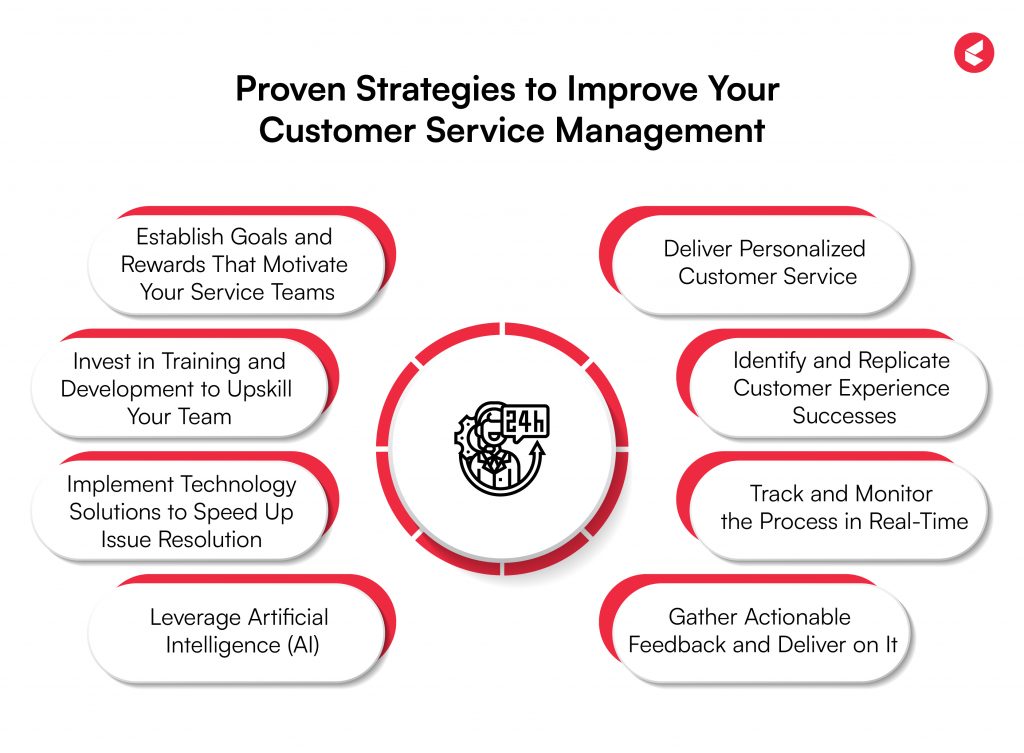
Improving customer service management at your organization begins with reflecting upon the business, its operational capabilities, and service limitations. Working from there, follow the step-by-step process described below to come up with a tailored blueprint for your company:
Step 1: Establish Goals and Rewards That Motivate Your Service Teams
Teams with a clear objective typically display better productivity and performance. Therefore, set achievable goals that allow your teams to monitor their performance and give them realistic KPIs to chase.
It is also important to recognize success and give appropriate rewards and recognition to keep your team members motivated toward the goal. Personalizing the rewards you hand out for goal achievement will improve participation in the initiative.
For instance, for an agent who consistently delivers great customer service, you can display positive customer messages as a shoutout on your department’s employee channels.
Step 2: Invest in Training and Development to Upskill Your Team
A crucial aspect of customer support management is building a team that has the skills to navigate this fragile job. Hiring talented people is only one part of the process. Provide your team members with knowledge bases to facilitate self-guided learning.
Additionally, you can use your learning management system (LMS) to disseminate compulsory online courses, training, or workshops that help upskill your team members based on their service aptitudes (like technical or general helpdesk).
You should also explore opportunities for mentor-mentee sessions that help the juniors gain skill points quicker when guided practically by senior members.
Step 3: Implement Technology Solutions to Speed Up Issue Resolution
To balance the scale of customer service, you need to consider two aspects: more channels mean more work for your service agents, and fewer channels mean fewer options for your customers to contact you.
It may sound like a trade-off, but the truth is that with modern technologies, you don’t have to face the burden of making this choice.
Leverage an integrative software like Kapture CX to provide a single-thread view of customer conversations across all channels in a single window. This unifies multichannel service and brings together the conversation history for the agent to quickly read through for a better service context.
Leverage Kapture CX’s omnichannel dashboard view to bring all your support channels together and provide support that is contextually relevant and seamless.
Step 4: Leverage Artificial Intelligence (AI)
As discussed, more and more customers today feel the need for better self-service options with their favorite brands. AI is capable of gathering, collating, and analyzing large sets of data, empowering you to design interactive chatbots and virtual assistants that make service relevant and targeted.
While chatbots are simple and can solve basic queries, integrating them with AI, natural language processing (NLP), and machine learning (ML) makes them capable of far more. These intelligent self-service options, powered by Generative UI, can accompany your customers throughout their brand journey, answer their questions, provide recommendations, summarize product feedback, help them with checkout and offers, and so much more.
It all contributes to an excellent customer experience. In addition to improving self-service capabilities, AI helps reduce the burden on service agents.
Step 5: Deliver Personalized Customer Service
With enough customer data and the right analytic tools, your business can master service personalization for your customers.
For example, say that your business has hired a new team of contact center agents. A loyal customer places a call, expecting the agent already to know the history of their association with the company and provide services accordingly. However, the new agent knows next to nothing about the customer, and the service is not personalized and also falls short of expectations.
It is important to implement technologies that quickly provide agents with a summary of each customer.
For example, order history, purchase, and payment details, and other related details help the agent understand how to service this customer properly. This prevents service mishaps and case mishandling.
Step 6: Identify and Replicate Customer Experience Successes
Study your own customer service successes, and research your competitors for their service success as well. Treat these cases as models to guide your customer service management strategies. Carefully analyze the process and responses of the successful agents, and how they handled a ticket or a case, to help your own agents derive learning from it.
Creating examples of successful cases helps your agents craft their own approaches when handling similar cases.
For example, you can conduct drills in which you replay the recording of an angry customer and have your agents formulate their own strategies for calming the situation to ensure the call ends on at least a neutral note.
Step 7: Track and Monitor the Process in Real-Time
Businesses already record all their customer conversations across all channels “for quality and training purposes.” Establish a real-time monitoring mechanism where senior agents can interrupt conversations that could potentially develop into service failures. This helps salvage harmful situations before they cause much damage.
Real-time monitoring is crucial to prevent escalations and mobilize mechanisms (like AI assistance for agents) to steer a call in favor of the customer and the business. It also helps to quickly escalate severe service issues and get a senior management officer online through flags and alerts.
Step 8: Gather Actionable Feedback and Deliver on It
Feedback is a guiding beacon for customer service improvement ideas. They are the most direct form of actionable goals that your business can set and start acting on.
For example, don’t ask your customers Yes/No questions like “Was the service satisfactory?” Instead, give them a multiple-choice type question like “What would you like to improve in this service?” followed by options like “More menu options,” or, “Better detail”, “More personalization”, etc.
This engages a customer better. It is more convincing that as a business, you are trying to improve towards goals that your customers can clearly expect in the future.
The Impact of Powering CSM Strategies with GenAI Solutions
In a study conducted by The Boston Consulting Group, it was found that GenAI can enhance service agent productivity by up to 50%.
Generative AI (GenAI) is inherently different from traditional AI. While AI uses data to create predictions, forecasting, analysis, and derive insight, GenAI uses data to generate its own content.
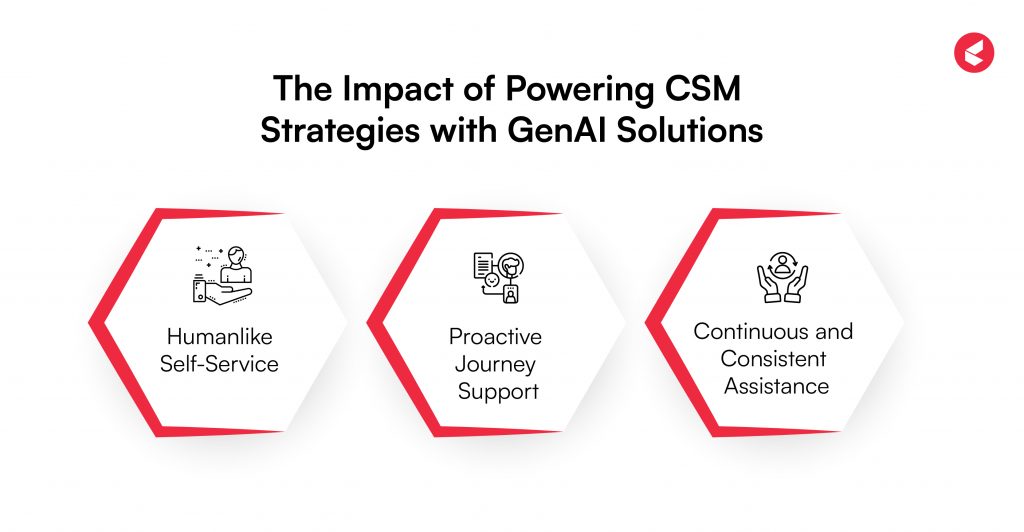
In the field of customer service, GenAI has the potential to revolutionize operations in three key ways:
- Humanlike Self-Service: GenAI powers versatile voice bots and chatbots that provide humanlike interactions. This also includes tools like Agent Assist, where GenAI quickly generates relevant, informative, and personalized responses for agents to guide their conversations with customers for positive outcomes.
- Proactive Journey Support: GenAI is capable of powering bots that are indistinguishable from human agents using advanced technologies like natural language processing (NLP). These bots are customized to user profiles and engage in proactive outreach to assist customers through their journey.
- Continuous and Consistent Assistance: Using GenAI, it is possible to create a personal brand assistant for each user that is capable of predicting customer needs, solving issues, making relevant suggestions and recommendations, and assisting the customer end to end through their journey.
GenAI can also help save time by eliminating the need for note taking while in conversation with a customer. It can generate summaries, highlight key points, and recommend further courses of action based on the conversation easily.
Leverage the Right Tools to Reinforce Your CSM Efforts
It can be challenging to streamline your customer support management. With a plethora of goals to work towards, prioritization and action can seem like tough tasks. However, with the right tools, your CSM teams can expertly tackle the challenges and level up their skills along the way.
Kapture CX provides AI-powered solutions that strengthen your CSM strategy with key tools like auto-evaluation of customer interactions, real-time scoring, speech and text analysis, and more. Leverage the tailor-made CX solutions, which offer built-in customizations for creating excellent customer experiences.
Interact with your customers across multiple channels with omnichannel support features that remove siloes from customer conversations. Empower your customers to navigate their queries with robust, AI-backed self-service options.
Schedule a demo today to get started!
FAQs
You can measure the performance of your CSM in metrics like CSAT scores, first-contact resolution, average response times, and customer churn rate. You want to aim high for CSAT and first-contact resolution and keep the response time and churn rates low.
Technology helps by automating CSM tasks like call routing, ticket organization and escalation, and more. You can leverage AI-based technologies to gain insight into customer conversations, implement self-service solutions, and predict future demands.
Some common CSM challenges are high call volume, complex customer issues, language barriers, and interdepartmental siloes. By using integrative technologies powered by AI, almost all of these challenges can be effectively solved.
Yes, your brand can build strong relationships with customers by listening to them actively. Displaying empathy with their problems helps them feel understood, leading to a better impression of your brand. You should consider personalized service and follow up regularly to make sure your customers know you think about them.
